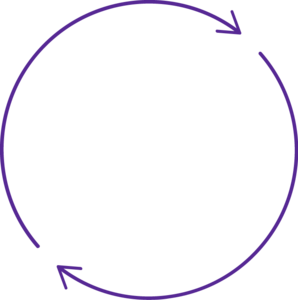The Circle of Trust

The Circle of Trust is a tool that can be used both individually and for groups. You can rate your circle of trust - think of your ‘inner circle’; work, school, or another group - to see how diverse the group of people you trust is.
Goal
This tool helps to uncover unconscious, affinity bias and come up with steps for improvement.
Materials
Instructions
Step 1:
What is Unconscious Bias?
- Unconscious biases, also known as implicit biases, are the underlying attitudes and stereotypes that people unconsciously attribute to another person or group of people that affect how they understand and engage with a person or group.
What is Affinity Bias?
- Affinity bias, also known as similarity bias, is the tendency people have to connect with others who share similar interests, experiences and backgrounds.
Choose 5 of your "go-to "people at work/school/another group - think of them as your inner circle - the people you consider trustworthy and whose counsel you seek in making decisions.
Step 2:
Once this is done, create 9 columns on a piece of paper.Step 3:
In the first column write your five trusted names.
Then add the other columns: Gender, Sexual Orientation, Race/Ethnicity, Age, Education Level, Nationality, Ableness, and Native Language.
Facilitator notes:*Ableness: Is their quality or condition of being able; ability; capacity for doing something similar to me?
Step 4:
Now place a tick [x] in the first column: gender. Place a tick for everyone that defines themselves as the same gender as you.Step 5:
Continue with the same for all of the columns: e.g “if you are heterosexual and the people you trust also are then you should have an [x] in that whole column”Step 6:
Reflection
When having done the whole exercise ask the participants to reflect on their circle - no one has to share any details - the focus here is on what their results made them think about.
-If you are male, are most of your trusted male too? If you are female, are the majority of your trusted females? Do those you trust look similar to you in age or race or education level? Are the majority of your same nationality?
-The results of the exercise lead well into a reflection or an open discussion.
Examples of reflection questions are: -How diverse is your circle of trust? -How might you diversify your inner circle of confidants? -In regards to a business strategy, how might embracing diverse perspectives, have an impact on: customer empathy? worldview of markets? potential customers? opportunities? possibilities….? What else?
Our closest advisors and those we rely on most for sound insight are often an unconscious mirror of ourselves. For example: If religion is a value in life, we may tend to trust other people of the same religion because we feel we have a set of common ‘underlying’ values that mirror each other.
It can be the same for gender, age, etc but if we move our circle of trust wider to include people that don’t mirror ourselves the patterns might change to be more inclusive.
Facilitation Note
It is important for this exercise to be accompanied by a facilitator that can moderate the reflection in the end.
To explore more about Unconscious Bias here are a few resources:
https://asana.com/resources/unconscious-bias-examples
https://fellow.app/blog/human-resources/unconscious-bias-examples-and-ways-to-avoid-them/
Want to assess which biases are most likely to affect you? Take Harvard’s Implicit Association Test—to figure out which of your individual perceptions are most likely to be governed by unconscious biases. Armed with that information, you can take proactive steps to address them on a personal basis.
Attachments
- 1.-circle-of-trust.png
- Circle-of-trust-cover.png
Background
Curated with Hyper Island's Digital Media Creative 2021 students (Intersectionality Group).
Sources: Tool designed by William Ek-Uvelius (Hyper Island Digital Media Creative 2021 student), ’Unconscious Bias: The Affinity Bias’, Catherine Louis, https://podojo.com/unconscious-bias-the-affinity-bias/ ‘A-ha’ activities for unconscious bias training’, Felicity Menzies, https://cultureplusconsulting.com/2018/08/16/a-ha-activities-for-unconscious-bias-training ’Who’s in your Top Ten?’, Tamryn Batcheller-Adams, https://www.tomorrowtodayglobal.com/2019/03/05/whose-in-your-top-ten/ ’The trusted ten’, Alyssa Ordu https://members.hustlecrew.co/the-trusted-ten/ Lecture with Hedvig Ahlberg, Panimation TV, 28/10/2020
Author
Hyper Island designs transformative learning experiences to enable growth – for individuals and for businesses. Unlike typical education or service providers, we follow a tried-and-tested methodology and a wide network of real industry experts. Through our global network of schools and business services, we put people at the heart of innovation, leadership and change – for success today and tomorrow.